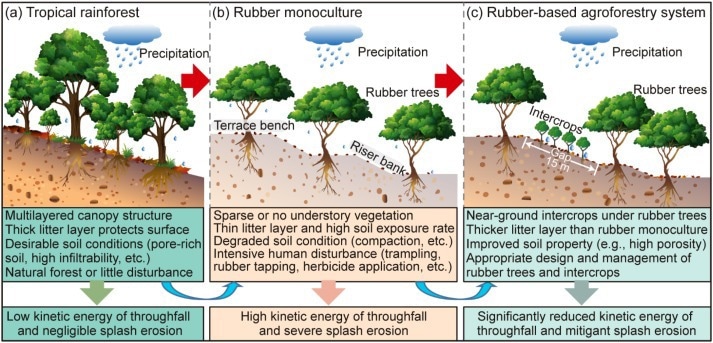Soil erosion frequently causes the deterioration of ecosystem services and functions all over the world. Splash erosion is the first stage of water erosion and significantly relates to soil particle disconnection on sloping land.
 Effect of land use/cover change on the soil splash erosion in Xishuangbanna, SW China. Image Credit: Xiai Zhu
Effect of land use/cover change on the soil splash erosion in Xishuangbanna, SW China. Image Credit: Xiai Zhu
Since splash erosion is common in the humid tropics due to the heavy rainfall, the progressive transition from large-scale tropical rainforests to rubber monoculture plantations and then to rubber agroforestry systems in Xishuangbanna and similar places should be supported by a greater understanding of splash erosion under innate rainfall conditions.
Scientists from the Chinese Academy of Sciences’ Xishuangbanna Tropical Botanical Garden (XTBG) supervised actual splash erosion and its prospective controls (rainfall parameters, vegetation structure, litter layer, soil properties) in tropical rainforest, rubber monoculture plantation, and four agroforestry systems in tropical areas, southwest China, in a study published in International Soil and Water Conservation Research.
The findings of the field observation revealed that the severity of splash erosion was strongly influenced by the land use regime.
The disturbed rubber monoculture soil was more susceptible to splash erosion, and the conversion of tropical rainforests to rubber monoculture was detrimental to splash erosion control. Accelerated splash erosion in monoculture rubber plantations may result in additional water erosion.
The combination of near-ground cash crops and rubber trees enhanced the vegetation system, ground cover, and soil conditions substantially. These enhancements lowered the kinetic energy of the through fall and the soil’s detachability, thereby reducing splash erosion. Intercropping tea and cacao with rubber trees was the most effective in reducing splash erosion among the four-agroforestry systems studied.
Furthermore, removing the litter layer enhanced splash erosion under the forest canopy considerably. Precipitation had a greater impact on soil splash erosion under a high single-layered canopy than under a low multilayered canopy.
To mitigate splash erosion, a key concern in land management practice should be the maintenance of forest litter, which shelters the soil surface from erosion.”
Xiai Zhu, Xishuangbanna Tropical Botanical Garden
“For the purposes of erosion control and the sustainable development of rubber plantations, in tropical regions with intense rainfall, rubber/tea and rubber/cacao systems with a low vegetation canopy and a good soil cover are appropriate intercropping patterns,” said Wenjie Liu of Xishuangbanna Tropical Botanical Garden.
Source:
Journal reference:
Zhu, X., et al. (2022) Soil splash erosion: An overlooked issue for sustainable rubber plantation in the tropical region of China. International Soil and Water Conservation Research. doi.org/10.1016/j.iswcr.2022.05.005.